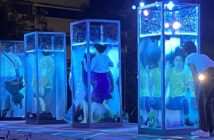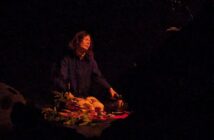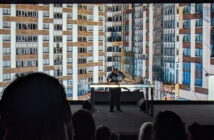The Cut Up was the latest in the series of free Sunday afternoon talks currently running at ACMI to tie-in with the Centre Pompidou Video Art 1965-2005 exhibition. Assistant Curator Emma Mayall introduced the proceedings, and David Shea, Dan Angeloro and Dominic Redfern were all on hand to give their own personal takes on what sampling/appropriation, pastiche and montage means to them.
Emma Mayall began by showing an excerpt from Martin Arnold’s Alone. Life Wastes Andy Hardy. This unnerving piece utilised found footage from a 1930s film starring Mickey Rooney and Judy Garland. The work featured scenes where the actors’ movements were atomised into individual tics and gestures, and a whole new narrative of Oedipal weirdness emerged.
American composer David Shea was the first to talk about how cut-ups and sampling have been an integral part of his work for nearly twenty years now. Shea is one of the most intellectual of composer/recording artists, whose work effortlessly melds influences from high and low art, whilst utilising practices informed by post-structuralist critical theory. Shea explained how he has recently been composing using samples from 1960s lounge and exotica recordings by the likes of Esquivel, Les Baxter et al. He also amusingly recalled his days in the downtown Manhattan music scene of the late 1980s – where one night he’d be scraping a living as a hip-hop DJ, and the next night would find him playing the wildest free improv with skronking sax players and the like.
Dan Angeloro of Soda_Jerk (Sydney-based video remix duo) then spoke about how modern sampling techniques allowed her to make her latest film without ever having to remove the lens cap from the camera, as she put it. Pixel Pirate II: Attack of the Astro Elvis Video Clone was constructed entirely using excerpts (video and audio) from pre-existing films. A couple of clips from this 1 hour long film were screened, and the assembled audience derived much mirth from a scene which artfully remixed the ‘Dawn of Man’ sequence from Kubrick’s 2001, until the apes were effectively breakdancing to hip-hop beats. Interestingly Dan name-checked DJ Kool Herc, Grandmaster Flash and Afrika Bambaataa as all being influential in the way that Soda_Jerk approach their art practices. The use of found footage brought Angeloro to the vexed question of how sampling bumps up against antiquated copyright and intellectual property laws. She said that Soda_Jerk had not encountered any legal problems thus far, but this was probably due to them flying under the commercial radar, rather than an avoidance of anything potentially litigious in their art.
Dominic Redfern is a local video artist who is also a lecturer in video art at RMIT – which I guess means he can produce an artwork, and then give you a 100% coherent explanation for what he’s done and why he’s done it. Redfern began by giving us a potted history of the appropriation of images in film, talking about such figures as American artist Bruce Conner. He mentioned the unsung VJs of the Peppermint Lounge in NYC in the early 1980s, who came up with a signature image of Neil Armstrong on the moon, which was itself lifted by MTV for a station ident soon after. Redfern showed three short films, which moved from pure abstraction to a realm of (literally) kitchen sink drama – albeit a domestic drama where a man meets his electronic, ectoplasmic doppelganger sitting at the breakfast table. (Not coming to Neighbours anytime soon, then.) Redfern’s films were also notable for a use of carefully sculpted noise on the soundtracks.
Ewan Burke



